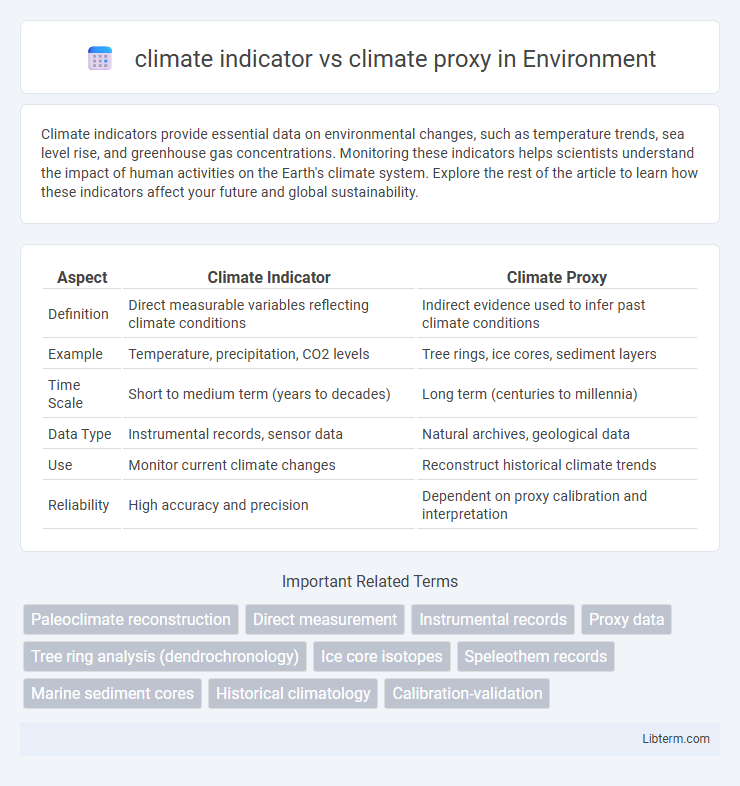Climate indicators provide essential data on environmental changes, such as temperature trends, sea level rise, and greenhouse gas concentrations. Monitoring these indicators helps scientists understand the impact of human activities on the Earth's climate system. Explore the rest of the article to learn how these indicators affect your future and global sustainability.
Table of Comparison
| Aspect | Climate Indicator | Climate Proxy |
|---|---|---|
| Definition | Direct measurable variables reflecting climate conditions | Indirect evidence used to infer past climate conditions |
| Example | Temperature, precipitation, CO2 levels | Tree rings, ice cores, sediment layers |
| Time Scale | Short to medium term (years to decades) | Long term (centuries to millennia) |
| Data Type | Instrumental records, sensor data | Natural archives, geological data |
| Use | Monitor current climate changes | Reconstruct historical climate trends |
| Reliability | High accuracy and precision | Dependent on proxy calibration and interpretation |
Introduction to Climate Indicators and Proxies
Climate indicators are direct measurements or observations of current environmental conditions, such as temperature, precipitation, and carbon dioxide levels, used to assess climate change. Climate proxies are indirect evidence from natural recorders like tree rings, ice cores, and sediment layers that provide historical climate information spanning centuries to millennia. These proxies are essential for reconstructing past climate variability and understanding long-term climate trends beyond instrumental records.
Defining Climate Indicators
Climate indicators are measurable physical, chemical, or biological variables directly reflecting current or past climate conditions, such as temperature records, ice core data, or atmospheric CO2 concentrations. These indicators help quantify climate changes by providing concrete data points tied to specific environmental parameters. Unlike proxies, which infer climate information indirectly through surrogate data like tree rings or sediment layers, climate indicators represent direct evidence essential for monitoring and modeling climate variability.
Understanding Climate Proxies
Climate proxies are indirect measures of past climate conditions derived from natural recorders such as tree rings, ice cores, and sediment layers, providing valuable insights into historical climate variability beyond the instrumental record. Unlike direct climate indicators like temperature or precipitation measurements, proxies rely on physical, chemical, or biological properties influenced by climate to reconstruct past environments. Understanding climate proxies involves interpreting these natural archives to assess long-term climate patterns, enabling researchers to extend climate data back thousands to millions of years.
Key Differences Between Indicators and Proxies
Climate indicators represent direct measurements of current environmental conditions, such as temperature, precipitation levels, and atmospheric CO2 concentrations, providing immediate data for climate analysis. Climate proxies infer past climate conditions through indirect evidence found in natural recorders like tree rings, ice cores, and sediment layers, offering insights into historical climate variability. The key difference lies in indicators measuring present conditions directly, while proxies reconstruct past climates from physical or biological archives.
Examples of Climate Indicators
Climate indicators include measurable variables like temperature records, atmospheric CO2 concentrations, and sea-level changes that directly reflect current climate conditions. Examples of climate indicators are global average surface temperature, Arctic sea ice extent, and the frequency of extreme weather events such as hurricanes or droughts. These indicators provide real-time data essential for monitoring ongoing climate trends and assessing the impact of human activities.
Examples of Climate Proxies
Climate proxies provide indirect evidence of past climate conditions through natural recorders like tree rings, ice cores, sediment layers, and coral reefs. Tree rings reveal annual growth variations linked to temperature and precipitation, while ice cores contain trapped air bubbles that preserve ancient atmospheric composition and temperature data. Sediment layers and coral reefs also store chemical signatures that help reconstruct historical climate changes over thousands to millions of years.
Importance in Climate Science
Climate indicators directly measure current atmospheric or environmental conditions, providing real-time data essential for monitoring ongoing climate changes. Climate proxies, such as tree rings, ice cores, and sediment layers, offer indirect evidence of past climate variations, enabling scientists to reconstruct historical climate patterns over millennia. Combining climate indicators and proxies allows for comprehensive understanding of climate dynamics, improving predictive models and informing effective mitigation strategies.
Applications in Historical Climate Analysis
Climate indicators provide direct measurements of environmental variables such as temperature, precipitation, or atmospheric composition, facilitating the reconstruction of recent climate trends with higher temporal resolution. Climate proxies, including tree rings, ice cores, and sediment layers, offer indirect evidence of past climate conditions, extending analysis over millennia and enabling study of long-term climate variability. Combining climate indicators and proxies enhances historical climate analysis by improving accuracy in tracing natural climate cycles and anthropogenic impacts.
Limitations and Challenges
Climate indicators provide direct measurements of current environmental conditions but often lack the temporal depth needed for long-term climate analysis. Climate proxies, such as tree rings and ice cores, extend historical climate records but face challenges like dating uncertainties and regional specificity. Both methods involve limitations in spatial resolution and sensitivity to confounding factors, complicating accurate climate reconstructions.
Future Trends in Climate Measurement
Climate indicators, such as atmospheric CO2 levels and global temperature anomalies, provide direct, real-time data essential for tracking current climate changes, while climate proxies like tree rings and ice cores offer historical context by reconstructing past climate conditions. Future trends in climate measurement emphasize integrating high-resolution satellite observations with advanced proxy data to enhance predictive models and improve accuracy in forecasting climate variability. Emerging technologies in remote sensing and machine learning are driving the development of more precise indicators that will enable faster detection of climate shifts and support adaptive mitigation strategies.
climate indicator Infographic

 libterm.com
libterm.com